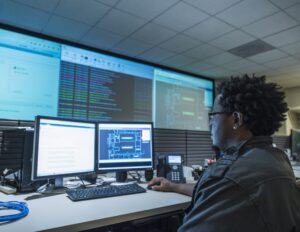The word is out and data center owners are getting the message: Lithium-ion (Li-ion) batteries bring big benefits to data center back-up systems, including uninterruptible power supplies (UPSs), most notably a lower total cost of ownership.
That’s the gist of a new report from Bloomberg New Energy Finance[1], which forecasts that in 2025 Li-ion batteries will account for 5.6GWh of data center battery backup capacity, as compared to 8.3GWh for traditional valve-regulated lead-acid (VRLA) batteries (see Figure 1 below). That means Li-ion technology will snatch 40% of market share in just 8 years. In a market that’s not exactly known for making rapid technological shifts, that is nothing short of remarkable. While VRLA has much lower upfront cost today, lithium-ion batteries will experience significant cost reductions, driven by sizeable ramp-up in demand in the coming decade, much of which will be for electric vehicles. This cost reduction and increasing familiarity with the use of lithium-ion batteries for back-up in data centers will help ramp up adoption in this timeframe.
Figure 1: North America and Europe data center annual battery back-up demand, 2016-25 (GWh)Meanwhile, there is still a significant proportion of the market that will still continue to use VRLA, and lead-acid battery technology is also improving. However, li-ion will gain even more share in hyperscale data centers – those owned by Internet Giants such as Amazon, Facebook and Google – where wringing every bit of energy and space efficiency means huge savings. Li-ion is expected to account for about 55% of backup capacity in such data centers in 2025, the Bloomberg Finance report forecasts (see Figure 2 below).
Figure 2: North America and Europe annual data center lithium-ion penetration by type, 2016-25 (GWh)This is no surprise to me at all, given the many benefits that Li-ion technology brings to centralized data center UPS systems. We’ve been talking up these benefits for quite some time, such as in this post from 2015 touting “4 Big Benefits of Lithium Ion Batteries.” Another post from last year talks about the changes Li-ion technology will bring to data center UPSs, while this related post focuses specifically on the benefits for large data centers.
You can check out those posts for all the details, but in summary the benefits come down to these four:
- Double the battery life as compared to VLRA and simplified maintenance.
- Improved use of data center real estate due to a 50% to 75% reduction in secure power footprint, paving the way for more IT equipment.
- Improved management capabilities, including embedded management at the cell, module and cabinet levels, leading to predictable, consistent performance and battery health.
- Reduced data center cooling requirements, because Li-ion batteries take up less space and, unlike traditional VLRA batteries, can operate at higher temperatures without sacrificing battery life.
All of these benefits help to reduce costs in one way or another, adding up to a lower total cost of ownership for Li-ion UPS batteries over time as compared to VLRA. That is what has data center owners standing up and taking notice of Li-ion technology.
Schneider Electric was first to market with Li-ion UPS technology when we launched it last year and already we have the systems installed in more than 20 sites, totaling more than 10MWh of capacity. What’s interesting is those Li-ion installations range from large companies, including colocation providers and financial services companies with enterprise-level data centers, to industrial applications and even server rooms. Clearly the technology is applicable to a wide range of situations.
It’s heartening to read forecasts from the likes of Bloomberg New Energy Finance on how Li-ion technology will catch on for data center UPS systems because it means customers are getting the message on how the technology can help them run more efficient data centers, and save money. To learn more about Li-ion, check out FAQs for Using Lithium-ion Batteries with a UPS to help you decide if Li-ion is a fit for your business needs.
[1] This blog is based on a series of Bloomberg New Energy Finance reports focused on the telecoms and UPS market. Please visit https://about.bnef.com/contact/ for more information about how to become a BNEF client and access the reports.



